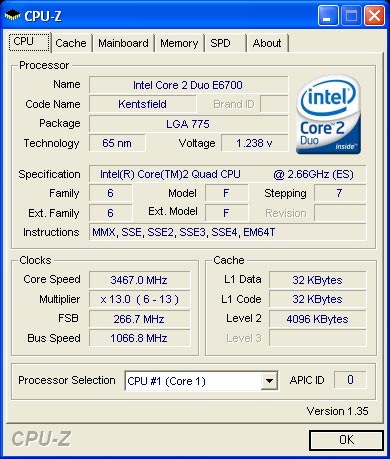Intel's Core 2 Extreme QX6700: The Multi-core Era Begins
by Anand Lal Shimpi on November 2, 2006 2:14 AM EST- Posted in
- CPUs
Overclocking
When Intel's first dual core CPUs hit the market, there was a significant gap in clock speed between them and the fastest single core CPUs. The fastest dual core Pentium Extreme Edition was introduced at 3.2GHz, while you could get a 3.73GHz single core CPU for similar money. The single core Pentium 4 Extreme Edition had a 16.5% clock speed advantage, that you had to give up in order to get a second core at the high end.
Of course back then, clock speed mattered, and it was frequency that got you reasonable performance out of Intel's NetBurst architecture. You gave up much less if you looked at the AMD side of things; their fastest single core CPUs at the time ran at 2.6GHz while the fastest dual core Athlon 64 X2s ran at 2.4GHz.
With Intel's Core microarchitecture, the situation with Kentsfield vs. Conroe is much more like the Athlon 64 vs. Athlon 64 X2. At $999 you've got a dual core 2.93GHz offering or a 2.66GHz quad core offering, and at that price point the decision isn't too hard to make, especially when you take into account that you can overclock Kentsfield pretty well.
Like all other Core 2 Extreme processors, the QX6700 has a mostly unlocked clock multiplier, allowing you to easily overclock to higher frequencies. So while you can't take a Core 2 Extreme X6800 and give it more cores, you can always take a QX6700 and run it at X6800 speeds to have your cake and eat it too.
We managed to get our QX6700 sample up to 3.2GHz (12 x 266MHz) at the CPU's stock voltage of 1.35V, which isn't bad at all considering we didn't employ any exotic cooling. Bumping the core voltage up to 1.3875V we were able to gain an extra 266MHz and run at 3.46GHz.

You lose some overclocking headroom given the added heat output of the extra die on the chip, not to mention that both die have to be capable of running at the overclocked speed, but overall Kentsfield doesn't look too bad as an overclocker's chip. It's not the bang for your buck that the E6300 offers, but at $999 that's not what we're expecting to begin with.










59 Comments
View All Comments
JarredWalton - Thursday, November 2, 2006 - link
I am quite sure that 4x4 is for 1207 and not AM2. Sorry. I am also quite sure that 1207 will get quad core support, so long-term a 4x4 (dual dual core) can become... 4x8? (dual quad core). Anyway, in that sense it's just like Core 2 Duo and Quad.The questions I don't have answers to: will the 4x4 begin with a K8L chip, or just a tweaked K8? Will K8L be more competitive with Core 2? When will it finally come out? How much will it cost? Actually, I can sort of guess on the last point that 4x4 will cost a lot more than a Core 2 Quad config as you will need a more expensive mobo, RAM, and two CPU packages.
I *think* Anand plans to have an article delving into 4x4 and AMD's plans more in the future. Maybe he's still gathering data from AMD? (Sort of like squeezing water from a dry spongue at times, unfortunately....)
johnsonx - Thursday, November 2, 2006 - link
I don't think you're right on that one; 4x4 CPU's will use the same RAM as AM2 CPU's do. The "more expensive RAM" requirement is only for Opterons, which of course use registered ECC memory. In fact, if your chosen mainboard has memory banks for both CPU's, then you could even save a little since 4 smaller DIMMs tends to cost a little less right now than 2 bigger DIMMs.
JarredWalton - Thursday, November 2, 2006 - link
Except that like socket 940 vs. 939, I expect all 1207 boards to require registered DIMMs. I don't know of any dual socket board that doesn't.Griswold - Thursday, November 2, 2006 - link
The whole "catch" of 4x4 was that there are no ECC/Registered DIMMS required - at least that was the synopsis all the time. It should have very little to do with the socket itself, rather a matter of IMC, no?Anand Lal Shimpi - Thursday, November 2, 2006 - link
You're correct, 4x4 will use Socket-1207 CPUs but without Registered memory.Take care,
Anand
JarredWalton - Thursday, November 2, 2006 - link
I stand corrected, though I have to say I'm still not at all interested in getting a dual socket motherboard. LOL I guess 1207 CPUs will have to support both registered and unbuffered DIMMs? I can't imagine AMD trying to get people to make sure they get the right type of CPU for the RAM they're using.Second thought: could they have mobos and CPUs that will support both registered and unbuffered DIMMs? I think they have the same keying, so it's possible, right?
smilingcrow - Thursday, November 2, 2006 - link
Two dual-core 90nm 120W CPUs = No thank you.Two quad-core 65nm xW CPUs = interesting!
Jedi2155 - Thursday, November 2, 2006 - link
I'm personally a extremely heavy multi-tasker and I can't wait for quad to a hit a more managable price range. At the moment, they're just beyond my reach for a CPU alone. Once it hits around 300-500 then I would definitely buy one, but these right now are still for the rich and video encoders.AlabamaMan - Thursday, November 2, 2006 - link
I am still amazed by the fact that a $300 E6600 consistantly beats the $700 FX62Aikouka - Thursday, November 2, 2006 - link
That fact, my friend, is why I'm purchasing an E6600 in this upcoming week :). Simply the best performance without overclocking for the buck.